Italian Communist Party
The Italian Communist Party (Italian: Partito Comunista Italiano, PCI) was a communist political party in Italy.
Italian Communist Party Partito Comunista Italiano | |
|---|---|
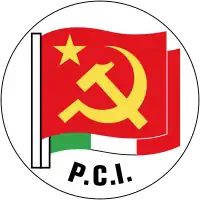 | |
| Abbreviation | PCI |
| General Secretaries |
|
| Founded | 21 January 1921[lower-alpha 1] |
| Dissolved | 3 February 1991 |
| Split from | Italian Socialist Party |
| Succeeded by |
|
| Headquarters | Via delle Botteghe Oscure 4, Rome |
| Newspaper | l'Unità |
| Youth wing | Communist Youth Federation |
| Membership (1947) | 2,252,446 ( |
| Ideology |
|
| Political position | |
| National affiliation |
|
| International affiliation |
|
| European Parliament group |
|
| Colours | Red |
| Chamber of Deputies | 228 / 630 (1976–1979) |
| Senate | 116 / 315 (1976–1979) |
| European Parliament | 27 / 81 (1984–1989) |
| Party flag | |
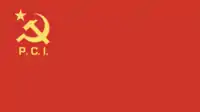 | |
| |
The PCI was founded as Communist Party of Italy on 21 January 1921 in Livorno by seceding from the Italian Socialist Party (PSI).[9] Amadeo Bordiga, Antonio Gramsci, and Nicola Bombacci[10] led the split. Outlawed during the Fascist regime, the party played a major role in the Italian resistance movement. It changed its name in 1943 to PCI and became the second largest political party of Italy after World War II, attracting the support of about a third of the vote share during the 1970s. At the time, it was the largest communist party in the West, with peak support reaching 2.3 million members, in 1947,[11] and peak share being 34.4% of the vote (12.6 million votes) in the 1976 general election.
The PCI transitioned from doctrinaire communism to democratic socialism by the 1970s or the 1980s[12][13][14][15][16][17] and adhered to the Eurocommunist trend. In 1991, it was dissolved and re-launched as the Democratic Party of the Left (PDS), which joined the Socialist International and the Party of European Socialists. The more radical members of the organization formally seceded to establish the Communist Refoundation Party (PRC).
History
Early years
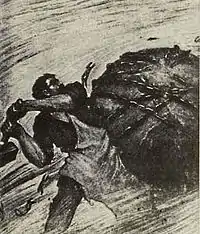
| Communism in Italy |
|---|
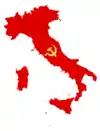 |
|
|
The roots of the Italian Communist Party date back to 1921, when the Communist Party of Italy (Partito Comunista d'Italia; PCdI) was founded in Livorno on 21 January, following a split in the Italian Socialist Party (PSI) on their 17th Congress. The split occurred after the socialist Congress of Livorno refused to expel the reformist group as required by the Communist International (Comintern). The main factions of the new party were L'Ordine Nuovo, based in Turin and led by Antonio Gramsci, and the "maximalist" faction led by Nicola Bombacci. Amedeo Bordiga was elected Secretary of the new party.[18]
The party was officially founded with as Communist Party of Italy – Section of the Communist International (Partito Comunista d'Italia – Sezione dell'Internazionale Comunista), since the Comintern was structured as a single world party according to Vladimir Lenin's vision.
In 1921, PCdI participated to its first general election, obtaining 4.6% of the vote and 15 seats in the Chamber of Deputies. At the time, it was an active yet small faction within the Italian political left, which was strongly led by the Socialist Party, while on the international plane it was part of Soviet-led.
During its 2nd Congress in 1922, the new party registered 43,000 members. This was in part due to the entrance of almost the whole Socialist Youth Federation (Federazione Giovanile Socialista). The party adopted a slim structure headed by a Central Committee of 15 members, five of whom were in the Executive Committee as well, namely Ambrogio Belloni, Nicola Bombacci, Amadeo Bordiga (EC), Bruno Fortichiari (EC), Egidio Gennari, Antonio Gramsci, Ruggero Grieco (EC), Anselmo Marabini, Francesco Misiano, Giovanni Parodi, Luigi Polano, Luigi Repossi (EC), Cesare Sessa, Ludovico Tarsia, Umberto Terracini (EC).
Since its formation, the party strived to organize itself on some bases which were not a mere reproduction of the traditional parties' bases, but then it took again some arguments that distinguished the battle within the PSI, namely the idea that it is necessary to form an environment fiercely hostile to bourgeois society and that is an anticipation of the future socialist society. The purpose of this is not utopian because already in this society, especially in production, some structures are born on future results. In the first years of the PCdI, there was no official leader, but the accepted leader, first of the faction/tendency and then of the party, was Amadeo Bordiga of the Left current. Leaders of the minority currents were Angelo Tasca (Right) and Antonio Gramsci (Center).
The conflict between factions
As a territorial section of Comintern, the PCdI adopted the same program, the same conception of the party and the same tactics adopted by the II Congress in Moscow of 1920. The official program, drawn up in ten points, began with the intrinsically catastrophic nature of the capitalist system and terminated with the extinction of the state. It follows in a synthetic way the model outlined by Lenin for the Communist Party of the Soviet Union (CPUS). For a while, this identity resisted, but the fast progress of the reaction in Europe produced a change of tactics in a democratic direction within the PCUS and consequently within the Comintern. This happened in particular regarding the possibility, previously opposed, of an alliance with the social democratic and bourgeois parties. This provoked a tension in the party between the majority (Left) and the minority factions (the Right and the Center) supported by the Comintern. The proposals of the Left were no longer accepted and the conflict between the factions became irremediable.
Bolshevisation
In 1923, some members of the party were arrested and put on trial for "conspiracy against the State". This allowed the intense activity of the Communist International to deprive the party's left-wing of authority and give control to the minority centre which had aligned with Moscow.
In 1924–1925, the Comintern began a campaign of "Bolshevisation" which forced each party to conform to the discipline and orders of Moscow. During the clandestine conference held in Como to ratify the party leadership in May 1924, 35 of the 45 federation secretaries, plus the secretary of the youth federation, voted for Bordiga's Left, four for Gramsci's Centre and five for Tasca's Right.
Before the Lyon Congress in 1926, the Centre won almost all the votes in the absence of much of the Left, who were unable to attend as a result of fascist controls and lack of Comintern support. Recourse to the Comintern against this evident manoeuvre had little effect.
The PCdI as conceived by the Left terminated. The organisation continued with the support of the Comintern and a new structure and leadership. In 1922, the newspaper L'Ordine Nuovo was closed and in 1924 a new Centre newspaper, l'Unità, edited by Gramsci, was founded. The Left continued as a faction, principally functioning in exile. It published the newspaper Bilan, a monthly theoretical bulletin.
In 1926, Bordiga and Gramsci were arrested and imprisoned on the island of Ustica. In 1927, Palmiro Togliatti was elected secretary in place of Gramsci. In 1930, Bordiga was expelled from the Comintern and accused of Trotskyism.
In 1943, Joseph Stalin dissolved the Communist International and on 15 May the exiled members of the PCdI in Moscow changed the party's name to the PCI. Under this name, it reorganised in Italy and became a parliamentary party after the fall of Fascism.
Name change
On 15 May 1943, the party changed its official name in Italian Communist Party (Partito Comunista Italiano), often shortened to PCI.
This change was not surprising as PCI started being used as the party's acronym around 1924–1925. This name change also reflected a change in the Comintern's role—it increasingly became a federation of national communist parties. This trend accelerated after Lenin's death and its new name emphasized the party's shift from an international focus to an Italian one. At the time, it was a hotly contested issue for the two major factions of the party. On one side, the Leninist preferred the single world party as it was internationalist and strongly centralized while on the other side the Italians wanted a party more tailored to their nation's peculiarities and more autonomy.
World War II
After the fall of Mussolini's regime on 25 July 1943, the Communist Party returned to a formally legal status, playing a major role during the national liberation, known in Italy as Resistenza ("Resistance") and forming many partisan groups.
In the April 1944 after the so-called svolta di Salerno (Salerno's turn), Togliatti agreed to cooperate with King Victor Emmanuel III and his Prime Minister, the Marshal Pietro Badoglio. After the turn, Communists took part in every government during the national liberation and constitutional period from June 1944 to May 1947.[19] The Communists' contribution to the new Italian democratic constitution was decisive. The so-called "Gullo decrees" of 1944, for instance, sought to improve social and economic conditions in the countryside.[20] During Badoglio and Ferruccio Parri's cabinets, Togliatti served as Deputy Prime Minister.
During the Resistance, the PCI became increasingly popular, as the majority of partisans were communists. The Garibaldi Brigades, promoted by the PCI, were among the more numerous partisan forces.[21]
Post-war years
The PCI took part in the 1946 Italian general election and referendum, campaigning for the "republic". In the election, the Communists arrived third, behind the Christian Democracy (DC) and the Socialist Party, gaining almost 19% of votes and electing 104 members of the Constituent Assembly.[22] While the popular referendum resulted in the replacement of the monarchy with a republic,[23] with the 54% of votes in favour and 46% against.[24][25]
In May 1947, the PCI was excluded from the government. The Christian democratic Prime Minister, Alcide De Gasperi, was losing popularity, and feared that the leftist coalition would take power. While the PCI was growing particularly fast due to its organizing efforts supporting sharecroppers in Sicily, Tuscany and Umbria, movements which were also bolstered by the reforms of Fausto Gullo, the Communist Minister of Agriculture.[26] On 1 May, the nation was thrown into crisis by the murder of eleven leftist peasants (including four children) at an International Workers' Day parade in Palermo by Salvatore Giuliano and his gang. In the political chaos which ensued, the president engineered the expulsion of all left-wing ministers from the cabinet on 31 May. The PCI would not have a national position in government again. De Gasperi did this under pressure from US Secretary of State George Marshall, who'd informed him that anti-communism was a pre-condition for receiving American aid,[27][26] and Ambassador James C. Dunn who had directly asked de Gasperi to dissolve the parliament and remove the PCI.[28]
In the general election of 1948, the party joined the PSI in the Popular Democratic Front (FDP), but it was defeated by the Christian Democracy party. The United States spent over $10 million to support anti-PCI groups in the election.[29] Fearful of the possible FDP's electoral victory, the British and American governments also undermined their campaign for legal justice by tolerating the efforts made by Italy's top authorities to prevent any of the alleged Italian war criminals from being extradited and taken to court.[30][31] The denial of Italian war crimes was backed up by the Italian state, academe, and media, re-inventing Italy as only a victim of the German Nazism and the post-war Foibe massacres.[30]
The party gained considerable electoral success during the following years and occasionally supplied external support to centre-left governments, although it never directly joined a government. It successfully lobbied Fiat to set up the AvtoVAZ (Lada) car factory in the Soviet Union (1966). The party did best in Emilia-Romagna, Tuscany and Umbria, where it regularly won the local administrative elections; and in some of the industrialized cities of Northern Italy. At the city government level during the course of the post-war period, the PCI demonstrated (in cities like Bologna and Florence) their capacity for uncorrupt, efficient and clean government.[32] After the elections of 1975, the PCI was the strongest force in nearly all of the municipal councils of the great cities.[33]
From the 1950s to 1960s
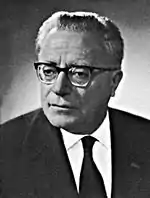
The Soviet Union's brutal suppression of the Hungarian Revolution of 1956 created a split within the PCI. The party leadership, including Palmiro Togliatti and Giorgio Napolitano (who in 2006 became President of the Italian Republic), regarded the Hungarian insurgents as counter-revolutionaries as reported at the time in l'Unità, the official PCI newspaper. However, Giuseppe Di Vittorio, chief of the communist trade union Italian General Confederation of Labour (CGIL), repudiated the leadership position as did prominent party member Antonio Giolitti and Italian Socialist Party national secretary Pietro Nenni, a close ally of the PCI. Napolitano later hinted at doubts over the propriety of his decision.[34] He would eventually write in From the Communist Party to European Socialism. A Political Autobiography (Dal Pci al socialismo europeo. Un'autobiografia politica) that he regretted his justification of the Soviet intervention, but quieted his concerns at the time for the sake of party unity and the international leadership of Soviet Communism.[35] Giolitti and Nenni went on to split with the PCI over this issue. Napolitano became a leading member of the miglioristi faction within the PCI which promoted a social-democratic direction in party policy.[36]
In the mid-1960s, the United States State Department estimated the party membership to be approximately 1,350,000 (4.2% of the working age population, making it the largest communist party in per capita terms in the capitalist world at the time and the largest party at all in the whole of Western Europe with the German Social Democratic Party).[37] United States government sources have claimed that the party was receiving $40–50 million per year from the Soviets while the United States investment in Italy was $5–6 million.[38] However, declassified information shows this to be exaggerated,[39] although the PCI relied on Soviet financial assistance more than any other communist party supported by Moscow.[39]
According to the former KGB archivist Vasili Mitrokhin, Longo and other PCI leaders became alarmed at the possibility of a coup in Italy after the Athens Colonel Coup in April 1967. These fears were not completely unfounded as there had been two attempted coups in Italy, Piano Solo in 1964 and Golpe Borghese in 1970, by military and neo-fascist groups. The PCI’s Giorgio Amendola formally requested Soviet assistance to prepare the party in case of such an event. The KGB drew up and implemented a plan to provide the PCI with its own intelligence and clandestine signal corps. From 1967 through 1973, PCI members were sent to East Germany and Moscow to receive training in clandestine warfare and information gathering techniques by both the Stasi and the KGB. Shortly before the May 1972 elections, Longo personally wrote to Leonid Brezhnev asking for and receiving an additional $5.7 million in funding. This was on top of the $3.5 million that the Soviet Union gave the PCI in 1971. The Soviets also provided additional funding through the use of front companies providing generous contracts to PCI members.[40]
Leadership of Enrico Berlinguer
In 1969, Enrico Berlinguer, PCI deputy national secretary and later secretary general, took part in the international conference of the Communist parties in Moscow, where his delegation disagreed with the "official" political line and refused to support the final report. Unexpectedly to his hosts, his speech challenged the Communist leadership in Moscow. He refused to "excommunicate" the Chinese Communists and directly told Leonid Brezhnev that the invasion of Czechoslovakia by the Warsaw Pact countries (which he called the "tragedy in Prague") had made clear the considerable differences within the communist movement on fundamental questions such as national sovereignty, socialist democracy and the freedom of culture. At the time the PCI, which had absorbed the PSI's left-wing, the Italian Socialist Party of Proletarian Unity, so strengthening its leadership over the Italian left, was the largest communist party in a capitalist state, garnering 34.4% of the vote in the 1976 general election.
Relationships between the PCI and the Soviet Union gradually fell apart as the party moved away from Soviet obedience and Marxist–Leninist orthodoxy in the 1970s and 1980s and toward Eurocommunism and the Socialist International. The PCI sought a collaboration with Socialist and Christian Democracy parties (the Historic Compromise). However, Christian Democrat party leader Aldo Moro's kidnapping and murder by the Red Brigades in May 1978 put an end to any hopes of such a compromise. The compromise was largely abandoned as a PCI policy in 1981. The Proletarian Unity Party merged into the PCI in 1984.
During the Years of Lead, the PCI strongly opposed the terrorism and the Red Brigades, who in turn murdered or wounded many PCI members or trade unionists close to the PCI. According to Mitrokhin, the party asked the Soviets to pressure the Czechoslovakian State Security (StB) to withdraw their support to the group, which Moscow was unable or unwilling to do.[40] This as well as the Soviet invasion of Afghanistan led to a complete break with Moscow in 1979. In 1980, the PCI refused to participate in the international conference of communist parties in Paris although cash payments to the PCI continued until 1984.[39]
Dissolution
Achille Occhetto became general secretary of the PCI in 1988. At a 1989 conference in a working-class section of Bologna, Occhetto stunned the party faithful with a speech heralding the end of Communism, a move now referred to in Italian politics as the svolta della Bolognina (Bolognina turning point). The collapse of the Communist governments in the Eastern Europe led Occhetto to conclude that the era of Eurocommunism was over. Under his leadership, the PCI dissolved and refounded itself as the Democratic Party of the Left, which branded itself as a progressive left-wing and democratic socialist party.[41] A third of the PCI membership, led by Armando Cossutta, refused to join the PDS and instead seceded to form the Communist Refoundation Party.[42]
Popular support
In all its history, the PCI was particularly strong in Central Italy, in the so-called "Red Regions" of Emilia-Romagna, Tuscany, Umbria and Marche, as well as in the industrialized cities of Northern Italy. However, Communists' municipal showcase was Bologna, which was held continuously by the PCI from 1945 onwards. Amongst other measures, the local PCI administration tackled urban problems with successful programmes of health for the elderly, nursery education and traffic reform[43] while also undertaking initiatives in housing and school meal provisions.[44] From 1946 to 1956, the Communist city council built 31 nursery schools, 896 flats and 9 schools. Health care improved substantially, street lighting was installed, new drains and municipal launderettes were built and 8,000 children received subsidised school meals. In 1972, the then-mayor of Bologna, Renato Zangheri, introduced a new and innovative traffic plan with strict limitations for private vehicles and a renewed concentration on cheap public transport. Bologna's social services continued to expand throughout the early and mid-1970s. The city centre was restored, centres for the mentally sick were instituted to help those who had been released from recently closed psychiatric hospitals, handicapped persons were offered training and found suitable jobs, afternoon activities for schoolchildren were made less mindless than the traditional doposcuola (after-school activities) and school programming for the whole day helped working parents.[33] Communists administrations at a local level also helped to aid new businesses while also introducing innovative social reforms.
The electoral results of the PCI in general (Chamber of Deputies) and European Parliament elections since 1946 are shown in the chart below.
Election results
Italian Parliament
| Chamber of Deputies | |||||
| Election year | Votes | % | Seats | +/− | Leader |
|---|---|---|---|---|---|
| 1921 | 304,719 (7th) | 4.6 | 15 / 535 |
Amedeo Bordiga | |
| 1924 | 268,191 (6th) | 3.6 | 19 / 535 |
Antonio Gramsci | |
| 1929 | banned | – | 0 / 400 |
Antonio Gramsci | |
| 1934 | banned | – | 0 / 400 |
– | Palmiro Togliatti |
| 1946 | 4,356,686 (3rd) | 18.9 | 104 / 556 |
Palmiro Togliatti | |
| 1948 | 8,136,637 (2nd)[lower-alpha 2] | 31.0 | 130 / 574 |
Palmiro Togliatti | |
| 1953 | 6,120,809 (2nd) | 22.6 | 143 / 590 |
Palmiro Togliatti | |
| 1958 | 6,704,454 (2nd) | 22.7 | 140 / 596 |
Palmiro Togliatti | |
| 1963 | 7,767,601 (2nd) | 25.3 | 166 / 630 |
Palmiro Togliatti | |
| 1968 | 8,557,404 (2nd) | 26.9 | 177 / 630 |
Luigi Longo | |
| 1972 | 9,072,454 (2nd) | 27.1 | 179 / 630 |
Enrico Berlinguer | |
| 1976 | 12,622,728 (2nd) | 34.4 | 228 / 630 |
Enrico Berlinguer | |
| 1979 | 11,139,231 (2nd) | 30.4 | 201 / 630 |
Enrico Berlinguer | |
| 1983 | 11,032,318 (2nd) | 29.9 | 198 / 630 |
Enrico Berlinguer | |
| 1987 | 10,254,591 (2nd) | 26.6 | 177 / 630 |
Alessandro Natta | |
| Senate of the Republic | |||||
| Election year | Votes | % | Seats | +/− | Leader |
|---|---|---|---|---|---|
| 1948 | 6,969,122 (2nd)[lower-alpha 2] | 30.8 | 50 / 237 |
– |
Palmiro Togliatti |
| 1953 | 6,120,809 (2nd) | 22.6 | 56 / 237 |
Palmiro Togliatti | |
| 1958 | 6,704,454 (2nd) | 22.2 | 60 / 246 |
Palmiro Togliatti | |
| 1963 | 6,933,842 (2nd) | 25.2 | 84 / 315 |
Palmiro Togliatti | |
| 1968 | 8,583,285 (2nd) | 30.0 | 101 / 315 |
Luigi Longo | |
| 1972 | 8,475,141 (2nd) | 28.1 | 94 / 315 |
Enrico Berlinguer | |
| 1976 | 10,640,471 (2nd) | 33.8 | 116 / 315 |
Enrico Berlinguer | |
| 1979 | 9,859,004 (2nd) | 31.5 | 109 / 315 |
Enrico Berlinguer | |
| 1983 | 9,579,699 (2nd) | 30.8 | 107 / 315 |
Enrico Berlinguer | |
| 1987 | 9,181,579 (2nd) | 28.3 | 101 / 315 |
Alessandro Natta | |
European Parliament
| European Parliament | |||||
| Election year | Votes | % | Seats | +/− | Leader |
|---|---|---|---|---|---|
| 1979 | 10,361,344 (2nd) | 29.6 | 24 / 81 |
– |
Enrico Berlinguer |
| 1984 | 11,714,428 (1st) | 33.3 | 27 / 81 |
Alessandro Natta | |
| 1989 | 9,598,369 (2nd) | 27.6 | 22 / 81 |
Achille Occhetto | |
Leadership
- Secretary: Antonio Gramsci (1926), Camilla Ravera (1927–1930), Palmiro Togliatti (1930–1934), Ruggero Grieco (1934–1938), Palmiro Togliatti (1938–1964), Luigi Longo (1964–1972), Enrico Berlinguer (1972–1984), Alessandro Natta (1984–1988), Achille Occhetto (1988–1991)
- President: Luigi Longo (1972–1980), Alessandro Natta (1989–1990), Aldo Tortorella (1990–1991)
- Leader in the Chamber of Deputies: Luigi Longo (1946–1947), Palmiro Togliatti (1947–1964), Pietro Ingrao (1964–1972), Alessandro Natta (1972–1979), Fernando Di Giulio (1979–1981), Giorgio Napolitano (1981–1986), Renato Zangheri (1986–1990), Giulio Quercini (1990–1991)
- Leader in the Senate: Mauro Scoccimarro (1948–1958), Umberto Terracini (1958–1973), Edoardo Pema (1973–1986), Gerardo Chiaromonte (1983–1986), Ugo Pecchioli (1986–1991)
- Leader in the European Parliament: Giorgio Amendola (1979–1980), Guido Fanti (1980–1984), Giovanni Cervetti (1984–1989), Luigi Alberto Colajanni (1989–1991)
Symbols
 1921–1945
1921–1945 1945–1951
1945–1951 1951–1991
1951–1991
Further reading
- Aldo Agosti, "The Comintern and the Italian Communist Party in Light of New Documents," in Tim Rees and Andrew Thorpe (eds.), International Communism and the Communist International, 1919–43. Manchester: Manchester University Press, 1998.
- Luigi Cortesi, Le origini del PCI. Laterza, 1972.
- Franco Livorsi, Amadeo Bordiga. Editori Riuniti, 1976.
- Paolo Spriano, Storia del Partito Comunista Italiano, vol. I Da Bordiga a Gramsci, Einaudi, 1967.
- La nascita del Partito Comunista d'Italia (Livorno 1921), ed. L'Internazionale, Milano 1981.
- La liquidazione della sinistra del P.C.d'It. (1925), L'Internazionale, Milano 1991.
- La lotta del Partito Comunista d'Italia (Strategia e tattica della rivoluzione, 1921–1922), ed. L'Internazionale, Milano 1984.
- Il partito decapitato (La sostituzione del gruppo dirigente del P.C.d'It., 1923–24), L'Internazionale, Milano 1988.
- Partito Comunista d'Italia, Secondo Congresso Nazionale – Relazione del CC, Reprint Feltrinelli, 1922.
Notes
- The official change of the party's name to the Italian Communist Party, was 15 May 1943
- Into the Popular Democratic Front.
References
- Ignazi, Pietro (1992). Il mulino (ed.). Dal PCI al PDS. ISBN 9788815034137.
- Bellucci, Paolo; Maraffi, Marco; Segatti, Paolo (2000). Donzelli (ed.). PCI, PDS, DS: la trasformazione dell'identità politica della sinistra di governo. ISBN 9788879895477.
- "Iscritti". Archived from the original on 10 November 2013. Retrieved 13 August 2011.
- De Rosa, Gabriele; Monina, Giancarlo (2003). Rubbettino (ed.). L'Italia repubblicana nella crisi degli anni Settanta: Sistema politico e istitutzioni. p. 79. ISBN 9788849807530.
- Cortesi, Luigi (1999). FrancoAngeli (ed.). Le origini del PCI: studi e interventi sulla storia del comunismo in Italia. p. 301. ISBN 9788846413000.
- La Civiltà Cattolica. Vol. 117. 1966. pp. 41–43. Archived from the original on 28 June 2018. Retrieved 28 June 2018.
- Tobagi, Walter (2009). Il Saggiatore (ed.). La rivoluzione impossibile: l'attentato a Togliatti, violenza politica e reazione popolare. p. 35. ISBN 9788856501124.
- Robbe, Federico (2012). FrancoAngeli (ed.). L'impossibile incontro: gli Stati Uniti e la destra italiana negli anni Cinquanta. p. 203. ISBN 9788856848304.
- "A Brief History of Italian Communism". A Brief History of Italian Communism | Communist Crimes. Retrieved 15 October 2020.
- Mack Smith, Denis (1994). Mussolini. London: Phoenix. p. 312. ISBN 1-85799-240-7.
- "Iscritti ai partiti". Archived 1 July 2007 at the Wayback Machine
- "Guide to the Italian Communist Party Collection, 1969–1971 1613". libraries.psu.edu.
- Joan Barth Urban (1986). Moscow and the Italian Communist Party: From Togliatti to Berlinguer. I.B.Tauris. p. 27. ISBN 978-1-85043-027-8.
- Enrico Morando (2010). Riformisti e comunisti?: dal Pci al Pd : i "miglioristi" nella politica italiana nella politica italiana. Donzelli Editore. p. 42. ISBN 978-88-6036-482-1.
- "Il socialismo democratico abita a Botteghe Oscure".
- "European Socialist Question Communist Party Independence".
- "Correnti interne al PCI".
- Paolo Spriano, Storia del Partito comunista italiano, Einaudi, 1967
- Monanelli, Cervi Storia d'Italia Rcs Quotidiani 2003
- Paul Ginsborg. A History of Contemporary Italy: Society and Politics, 1943–1988. Google Books. Retrieved 24 August 2013.
- G. Bianchi, La Resistenza, Storia d'Italia, vol. 8, p. 368
- Ministry of the Interior – 1946 Election Result
- "Dipartimento per gli Affari Interni e Territoriali". elezionistorico.interno.gov.it.
- "Il referendum istituzionale e la scelta repubblicana - Istituto Luigi Sturzo". Archived from the original on 5 March 2018. Retrieved 8 December 2016.
- "Savoia – Nuovi Dizionari Online Simone – Dizionario Storico del Diritto Italiano ed Europeo Indice H". simone.it.
- Ginsborg, A History of Contemporary Italy, pp. 106–113
- James Ciment, Encyclopedia of Conflicts Since World War II (Routledge, 2015)
- Corke, Sarah-Jane (12 September 2007). US Covert Operations and Cold War Strategy: Truman, Secret Warfare and the CIA, 1945–53. Routledge. pp. 47–48. ISBN 9781134104130.
- Corke, Sarah-Jane (12 September 2007). US Covert Operations and Cold War Strategy: Truman, Secret Warfare and the CIA, 1945–53. Routledge. pp. 49–58. ISBN 9781134104130.
- Italy's bloody secret (Archived by WebCite®), written by Rory Carroll, Education, The Guardian, June 2001
- Effie Pedaliu (2004) Britain and the 'Hand-over' of Italian War Criminals to Yugoslavia, 1945–48. Journal of Contemporary History. Vol. 39, No. 4, Special Issue: Collective Memory, pp. 503–529 JSTOR 4141408
- David Robertson (1993; 2nd edition). The Penguin Dictionary of Politics.
- Paul Ginsborg. A History of Contemporary Italy: Society and Politics, 1943–1988.
- The Italian Communists: foreign bulletin of the P.C.I., No. 4. Rome. October–December 1980. p. 103.
- Napolitano, Giorgio (2005). Dal Pci al socialismo europeo. Un'autobiografia politica (in Italian). Laterza. ISBN 978-88-420-7715-2.
- Paolo Cacace. "Napolitano e l'"utopia mite" dell'Europa" (in Italian). Archived from the original on 29 September 2007. Retrieved 14 July 2007.
- Benjamin, Roger W. and Kautsky, John H. (March 1968). Communism and Economic Development in the American Political Science Review. Vol. 62. No. 1 pp. 122.
- Carl Colby (director) (September 2011). The Man Nobody Knew: In Search of My Father, CIA Spymaster Ashley Colby (Motion picture). New York City: Act 4 Entertainment. Retrieved 15 September 2011.
Edward Luttwak, interview: "[W]e estimated at the time they were getting $40–50 million a year at a time when we were putting $5–6 million into Italian politics.
- Richard Drake (Summer 2004). The Soviet Dimension of Italian Communism. Journal of Cold War Studies. Vol. 6. No. 3. pp. 115–119.
- Andrew, Christopher and Mitrokhin, Vasili (2001). The Sword and the Shield: The Mitrokhin Archive and the Secret History of the KGB. Basic Books.
- "A Brief History of Italian Communism". A Brief History of Italian Communism | Communist Crimes. Retrieved 24 November 2020.
- Kertzer, David I. (1998). Politics and Symbols: The Italian Communist Party and the Fall of Communism. Yale University Press. ISBN 978-0-300-07724-7.
- Library of Nations: Italy, Time Life Books (1985).
- Cyrille Guiat. The French and Italian Communist Parties: Comrades and Culture. Google Books. Retrieved 24 August 2013.

